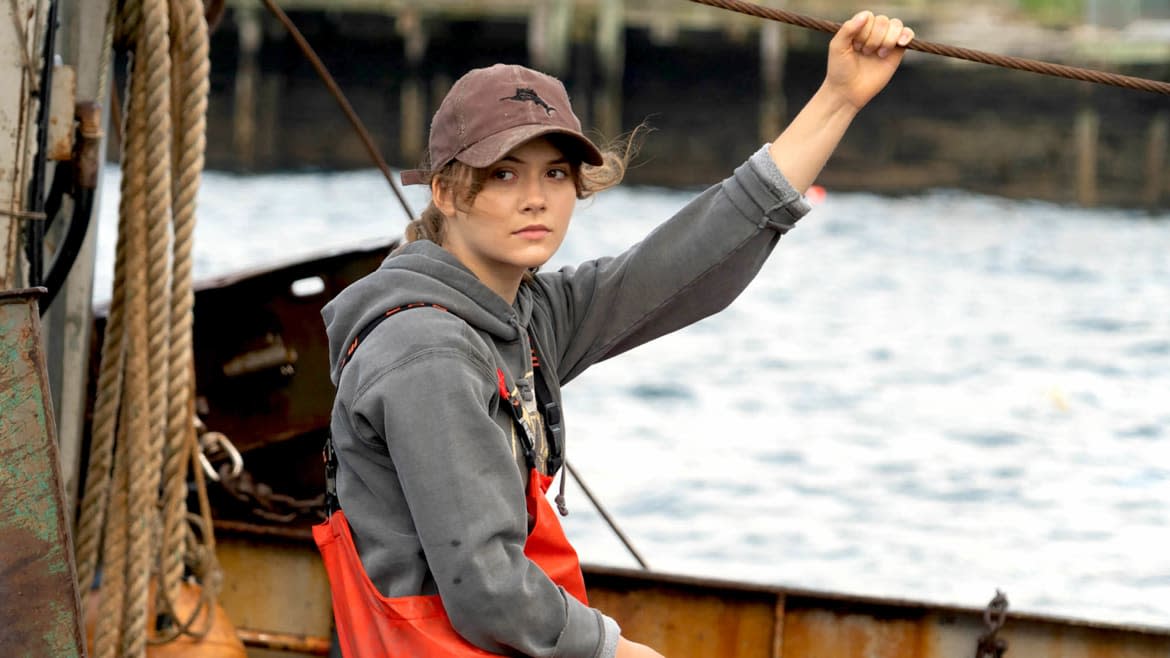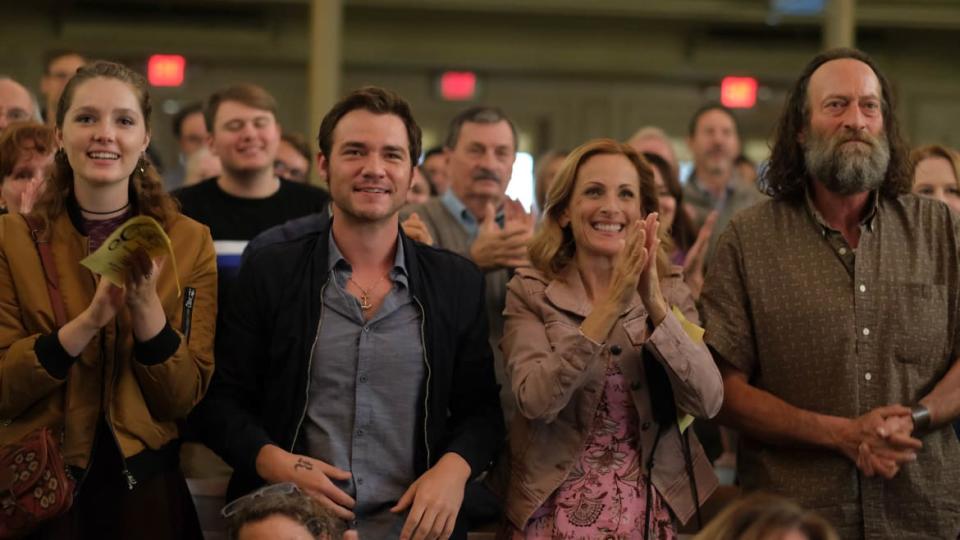Why the Deaf Family Dramedy ‘CODA’ Became Sundance’s Biggest Sale Ever

It took exactly 111 minutes from the start of the 2021 Sundance Film Festival for there to be an outrageous bidding war.
The premiere film at this year’s virtual festival—rather than the fanfare at the Eccles Theater in Park City, couches around the world were the primo seats—certainly set a tone for an unprecedented outing that had everyone in the industry wondering how the movie, and maybe more importantly the market, would play. As it turns out, very well.
On Saturday afternoon, it was announced that Apple Studios purchased the opening-night film CODA for a cool $25 million, meaning the first premiere of the first night of the first (and hopefully only) pandemic Sundance just set a record for the biggest sale in the festival’s history, beating last year’s surprise record-breaker, the Andy Samberg-Cristin Millioti Groundhog Day-inspired rom-com Palm Springs, which sold for $17.5 million… and 69 cents. (Nice.)
While a ribald comedy from the Saturday Night Live alum behind “Dick in a Box” had Park City’s thermal underwear bunched over its historic price-tag, CODA is a film more in line with the quirky-indie-that-could (in festival speak, that “could” stands for “crossover commercially”) that typically get studios excited to pull out their checkbooks.
That’s not to say that the CODA cash grab didn’t send shockwaves through the festival crowd. Breaking the previous record by $8 million is huge, especially for a film with no big-name stars. The industry is currently at a crossroads to boot, with movie theaters all over the world still closed, box-office receipts in freefall, and the effect of the COVID shutdowns on cinema still a hailstorm of question marks.
How ‘Sesame Street’ Was Inspired by Beer Commercials
Consider, then, this a $25 million gesture of good faith, one that couldn’t happen to a sweeter film.
Written and directed by Siân Heder, CODA has been described in shorthand as Glee meets Sound of Metal, the Riz Ahmed-starring film about a drummer grappling with his sudden hearing loss and attempting to acclimate into the hearing-impaired community. CODA really is a remarkable film, the kind that has musical sequences that would have garnered mid-screening rounds of applause from an excited festival audience, and so heartfelt it would have incited more than one group sobbing session on its way to a post-credits ovation.
With critics and filmmakers screening remotely from home this year, the clapping, crying, and celebration pivoted to social media, where immediately after the embargo broke those who had tuned in virtually tweeted ecstatically about the film, grateful for its uplift and, especially after this heavy year in the industry and in the world, some good, cathartic sobbing.
CODA stands for Children of Deaf Adults, unique members of the deaf community who are hearing but grew up with ASL as their first language.
Ruby, played by Emilia Jones, is the only hearing member of her family. Her mother (Oscar-winner Marlee Matlin), father (Troy Kutsur), and brother Leo (Daniel Durant) are all deaf and communicate using sign language.
They’re a fishing family—Ruby, Leo, and her dad start their day on the water at 3 a.m.—in Gloucester, Massachusetts, where the economic viability of the family business is waning. The smell of mackerel on her flannel only makes Ruby, who, while hearing, still is seen and identifies as an outsider in the halls of her high school, stick out even more.
She’s quiet and cautious, in contrast to her blunt and adventurous best friend Gertie (Amy Forsyth), but drums up the courage to sign up for choir as an elective. She does it partly because she has a crush on its star male singer Miles (Ferdia Walsh-Peelo), and partly because she harbors a buried desire to be a singer in her own right, a passion that flies in the face not just of her own family’s interests, but their capability to appreciate.
Eugenio Derbez plays the choir teacher with the expected flair—the concept of “gesticulation” itself has met its match here—and eyes potential in Ruby. He casts her as a soloist, teaming her up with Miles for a duet, and pushes her to audition for a scholarship to the Berklee College of Music. That’s how much promise he sees, despite her never having believed in herself.
He helps her find her voice and see a world beyond the limitations she thought her family’s circumstances would constrain her to. It is all incredibly on the nose in a film about a girl who grew up in a deaf family, and thank God for that. There’s no accounting for how truly, wonderfully special it is—there’s no word better or more fitting than that to describe this film—for this family’s story to be told in this way.
Not only does Ruby’s family not understand her interest in singing, they consider it a betrayal. They rely on her as an interpreter in every aspect of their lives and interactions with the hearing world. They are offended that she has chosen to center her life around something they cannot appreciate; they can’t hear her sing. “If I was blind, would you want to paint?” Her mother signs to her spitefully.
Ruby’s singing opens a Pandora’s box of things that have gone unsaid between mother and daughter. When they finally have it out, Ruby point-blank asks if her mother wished she had been born deaf, too. The answer is wrenching, but it’s more honest than any film in this genre normally has the courage to be.
Heder has crafted a narrative structured entirely by connecting dots between familiar beats of a coming-of-age story, or a coming-into-one’s-own story in this instance. You already know the road map as soon as things get started. But Heder calibrates each stop on the journey with perfect emotional pitch, not to mention sensitivity to characters and a community rarely represented on screen.
There are two kinds of music at play here, the songs that breathe new meaning into Ruby’s life, but also the sign language between the family as they communicate. They work in tandem to orchestrate a deeply emotional viewing experience. (Good luck getting through this film’s rendition of Joni Mitchell’s “Both Sides Now” with any of your faculties still intact.)
The reviews for CODA bordered on rapturous, much more positive than one would typically expect for a film that, at least structurally, adheres to such a tried-and-true formula. But then there’s the context of the times we’re in, a maelstrom of chaos and darkness, that make such a careful, open-hearted structure a rousing treat—one I don’t think took critics by surprise.
This is a film about how the arts can help center a person as they face their hardest battles in life, how a passion for them can help a person see themselves for who they really are, help heal them, and carry them toward a brighter future.

A scene from CODA, by director Siân Heder
It’s a film about how we yearn for connection, and how the arts—even if you don’t think that they can—are able to carry people across bridges to find common ground and truly understand each other.
How could you watch a film like that in times like these and not discover yourself thunderously moved?
For so many people who work in and around the film industry, last January’s Sundance was the last real “thing” of what’s now become known as Before Times—before the COVID shutdown.
The festival starting again is an unsettling and, in some regards, devastating reminder of how much time has passed, and how much has been lost and suffered. The logistics of a virtual festival are similarly bizarre and unmooring. With the weight of all that, to have things kick off with such splendor—it’s no wonder there’s been a watershed of emotion since CODA’s first screening.
Many wondered if a Sundance Film Festival in a pandemic would, or even could, attract buyers in the same way, or if the uncertainty facing the industry would make for a depressed market.
I’m just a critic and was obviously not in the room when the bidding started on CODA. But I like to believe that studios saw this film, a crowd-pleaser in the most respectful way that term can be applied, and saw an opportunity.
In breaking the Sundance sales record with the very first movie to officially screen, the studios that competed for CODA set the tone for the festival: a certainty in the future of the arts, of cinema, and of the power of connection. For many, that’s a message that doesn’t have a price tag.
Get our top stories in your inbox every day. Sign up now!
Daily Beast Membership: Beast Inside goes deeper on the stories that matter to you. Learn more.

